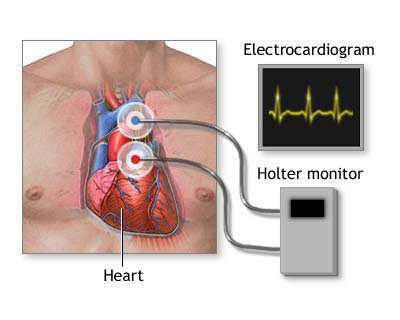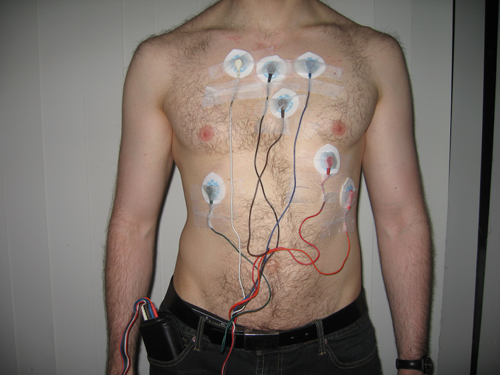Holter Monitor

What is a Holter Monitor
A Holter monitor (also called an ambulatory electrocardiography device), named after its inventor, Dr. Norman J. Holter, is a portable device for continuously monitoring the electrical activity of the heart for 24 hours or more.
How is the test performed?
Much like standard electrocardiography (ECG), the Holter monitor records electrical signals from the heart via a series of electrodes attached to the chest. The number and position of electrodes varies by model, but most Holter monitors employ from three to eight. These electrodes are connected to a small piece of equipment which is responsible for keeping a log of the heart's electrical activity throughout the recording period. You carry the Holter monitor in a pocket or in a small pouch worn around your neck or waist. The monitor is battery operated.
While you wear the monitor, it records your heart's electrical activity. You should keep a diary of what activities you do while wearing the monitor such as running and sleeping, symptoms, and times that their symptoms occur. This information is used by doctors and technicians to rapidly pinpoint problem areas in the vast amount of data recorded during the monitoring period.
After 24-hours, you return the monitor to your doctor's office. The doctor will look at the records and see if there have been any irregular heart rhythms. It is very important that you accurately record your symptoms and activities so that the doctor can match them with your Holter monitor findings.
How to prepare for test?
There is no special preparation for the test. Your doctor will start the monitor. You'll be told how to replace the electrodes, should they fall off or become loose. Tell your doctor if you are allergic to any tape or other adhesives. Make sure you shower or bathe before you start the test. You will not be able to do so while you are wearing a Holter monitor. Electrodes should be placed over bones to minimize artifacts from muscular activity.
How the Test Will Feel
This is a painless test. However, some people may need to have their chest shaved so the electrodes can stick. You must keep the monitor close to your body. This may make sleeping difficult for some people. You should continue your normal activities while wearing the monitor.

Why is the test performed?
Holter monitoring is used to determine how the heart responds to normal activity. The monitor may also be used:
• When starting a new heart medicine
• After a heart attack
• To diagnose heart rhythm problems
It can be used to diagnose:
• Multifocal atrial tachycardia
• Paroxysmal supraventricular tachycardia
• Palpitations
• Reasons for fainting
Risks
There are no risks associated with the test. However, you should be sure not to let the monitor get wet.
Considerations
Electrodes must be firmly attached to the chest so the machine gets an accurate recording of the heart's activity.
Avoid magnets, metal detectors, electric blankets, and high-voltage areas while wearing the device.
Event Monitor
Event monitor is a portable device for continuously monitoring the electrical activity of the heart for a month or more. Its extended recording period is useful for observing occasional cardiac arrhythmias that would be difficult to identify in a shorter period of time.
An example is the Transtelephonic Cardiac Event Monitor, this monitor contacts ECG technicians, via telephone, on a regular basis transmitting ECG rhythms for ongoing monitoring. The Transtelephonic Cardiac Event Monitor can normally store approximately 5 "cardiac events" usually lasting 30-60 seconds in duration.
Acknowledgements
Heart Rhythm Specialists of South Florida gives special thanks to the National Library of Medicine, Medtronic and National Heart Lung and Blood Institute whose Web sites aided in the research of the patient educational material provided above.






